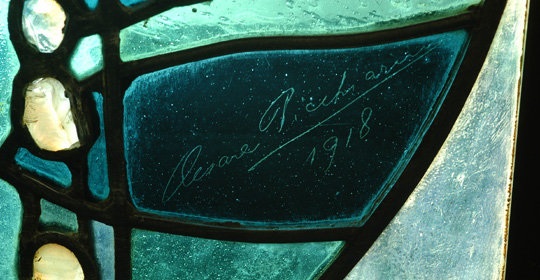How a stained glass window is made
The art of the lead-framed stained glass window – a widespread architectural feature from the Middle Ages to the nineteenth century – enjoyed renewed popularity at the start of the twentieth century. It achieved success at the Prima Mostra della Vetrata Artistica organised in 1912 by Cesare Picchiarini, who had attracted famous artists (Cambellotti, Paschetto, Grassi, Bottazzi) to the circle of his workshop.
These artists prepared cartoons for the windows that the master then executed with great technical skill. The technique used by the Picchiarini workshop evolved from simple, linear geometric patterns to sophisticated designs, like the windows in the Rose Balcony conceived by Paschetto in 1920, in which the decorative motif is characterised by an elegant graphism and exceptional compositional freedom.


A stained glass window begins with a small-scale, coloured drawing with varying degrees of detail that has to take into account the dimensions of the actual window. The choice of pictorial technique used in the drawing is a personal one, but usually watercolours are used.
The drawing is used to create a full-scale working drawing, called a cartoon, used to transfer the design into the medium of glass. The cartoon enables a drawing on translucent paper to be made in which the lines represent the panes of glass, the overall framework for the window and the lead structure that holds the individual panes of glass.
The master-glazier chooses the pieces of glass by checking their colouring and appearance when illuminated from behind; this is because the aesthetic success of the finished window depends to a great extent on the choice of colours.
Once the glass has been cut into the individual panes, these are cleaned and the edges bevelled. The panes are then fitted into the lead frame, though they are only welded at the joints using molten tin. The weld should be smooth, flat and completely fill the width of the frame.
Even though the pane has been welded, the panel is still fragile and so is reinforced by inserting a pasty substance in the remaining space between the glass and the lead. When this has dried, the panel is ready to be mounted in the overall framework.
In Italy the art of stained glass became established later than in the rest of Europe, and the technique followed is split into two phases: the inventive part in which the design is prepared by the artist, and the practical part in which the master-glazier turns the design into reality. This second phase is exemplified by the works exhibited in the museum.









































